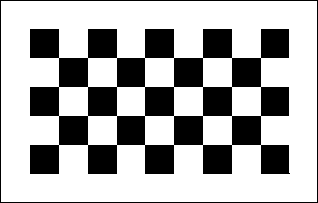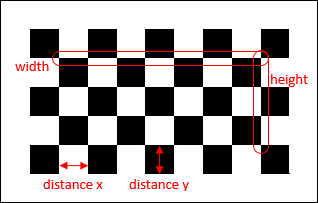Chessboard pattern
A chessboard pattern consists of alternating light and dark squares, which together form a rectangular pattern. See chessboard example below with 4 x 8 intersections:

Requirements for the pattern
- The pattern should be applied to a surface that is as flat as possible (planar), e.g. a glass pane.
- The light and dark squares must
- be arranged in an alternating pattern,
- have the same size
- and be square.
- A pattern must contain at least 16 fully visible squares, which together form at least 3 x 3 intersections.
- The background color around the pattern must form a 'quiet zone'.
Requirements for the image acquisition
- Exposure
- Homogeneous illumination of the pattern
- Good contrast between the light and dark squares in the image
- No opening at intersections due to overexposure
- Figure
- A square must be represented by at least 15x15 pixels.
Configuration in the Camera Calibration Assistant
- Width
Corresponds to the number of intersections in horizontal direction. - Height
Corresponds to the number of intersection points in vertical direction. - Distance x
Corresponds to the distance between two intersection points in horizontal direction. - Distance y
Corresponds to the distance between two intersection points in vertical direction.
